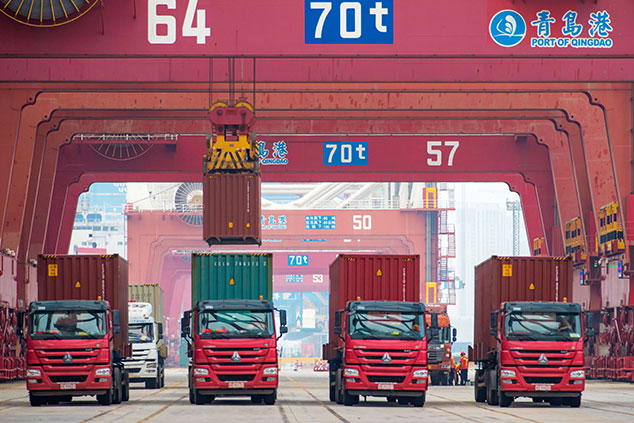
This article is taken from our FREE daily investment email Money Morning.
Every day, MoneyWeek’s executive editor John Stepek and guest contributors explain how current economic and political developments are affecting the markets and your wealth, and give you pointers on how you can profit.
China began publishing data on quarterly GDP performance in 1992.
Back then, no one outside China cared. It was a fast-growing emerging economy. It was exciting and fascinating to watch it develop, but it had little impact or relevance to the big picture.
Today, China is the world’s second-largest economy. Today, China matters.
And today, China just reported its slowest GDP growth since those figures were first made public.
China’s biggest slump in nearly 30 years
China’s GDP growth amounted to 6.2% in the second quarter of the year. That was down from 6.4% in the first quarter, and was also the slowest pace since quarterly records began in 1992. But it was broadly in line with expectations.
Now, we all know that China’s statistics are more politically influenced than those of most nations. So you can’t take the figures at face value.
But independent measures suggest that the direction of travel is similar. For example, Capital Economics runs its own measure, which suggests that recent growth came in at 5.2% versus 5.3% in the first three months.
What does it all mean? There’s a hint that growth perked up in June. That looks to be partly due to a loosening of credit conditions, as local governments borrowed more money. Manufacturing data picked up while retail sales climbed impressively.
According to a spokesman for the National Bureau of Statistics, reported in the FT, tax cuts this year have helped. “China’s economic growth is more and more reliant on domestic demand, especially on consumption.”
The thing is, given that China is currently feeling the squeeze from tariffs imposed by the US, this is the sort of spin that was always going to be put on the data. To be clear, it would be good news if China really is becoming more domestically-focused – that’s a healthy development. I’m just suggesting we take it with a pinch of salt.
Moreover, most analysts are pretty gloomy on the June data, seeing it as a one-off. They also reckon that the Chinese government won’t want quarterly GDP growth to fall below 6%. (That said, it could drop to 5.8% in the second half and the government could still claim to have hit its target of 6% for 2019).
So the consensus appears to be that we’re in for more stimulus from the Chinese government. Markets in turn have of course taken that as a decent reason to nudge stocks higher.
The one Chinese economic indicator to watch like a hawk
What does all of this mean for investors? Well, as long as the Chinese economy isn’t collapsing, then markets will probably be quite relaxed about a gentle slowdown, simply because it suggests that there will be looser monetary policy.
Markets have got it into their heads that anything that points to central banks or governments loosening monetary policy, anywhere in the world, is a good thing.
The big China-related risk as far as markets are concerned at the moment, is that the Chinese yuan (or renminbi) will collapse in value. A major devaluation would be unnerving for a number of reasons.
For a start, it would suggest that conditions had grown tough enough to force the Chinese government – which is pretty conservative, for a revolutionary party – to make an uncomfortably radical decision.
Secondly, a slide in the value of the Chinese currency would spark a collapse in consumer goods prices across the globe too (because Chinese exports would suddenly become very cheap to other countries, which would hammer their competition).
Thirdly, it would make it a lot more expensive for China to import goods, whacking an import source of demand for the global economy.
For now and the near future, such a devaluation seems unlikely. But you do have to wonder what the ongoing threat of a new round of “currency wars” might mean on this front.
On the one hand, if the US dollar weakens – as both Donald Trump and the Federal Reserve seem to be hoping for – then that might make life easier for China too.
The yuan is no longer pegged to the dollar, but the currency is still managed against a basket of currencies, of which the US dollar comprises a big part.
As a result, if the yuan stays broadly static against the dollar as the dollar weakens, then it becomes more competitive against other global currencies without necessarily incurring the wrath of the US.
On the other hand, if the US continues to accuse all and sundry of being currency manipulators, then the trade wars could take on a new dimension. (For example, Ireland was on the last watchlist issued by the US, which is pretty brutal, given that Ireland really doesn’t have much of a say in the policies driving the value of the euro).
Then there’s the situation in Hong Kong. The Hong Kong dollar is pegged to the US dollar. That peg has proved one of the most durable in the world. But if the US gets sufficiently troubled by events in Hong Kong, it could be threatened by politics, rather than economics.
So in all, the thing to watch if you’re worried about China, is the exchange rate. So far the line in the sand has been ¥7 to the US dollar, and for now that’s the line to watch. We report on it every week in Saturday’s Money Morning roundup email.
We’ll have a lot more on China, trade and the state of global monetary policy at the MoneyWeek Wealth Summit in November. Get your early bird ticket here, while they last.